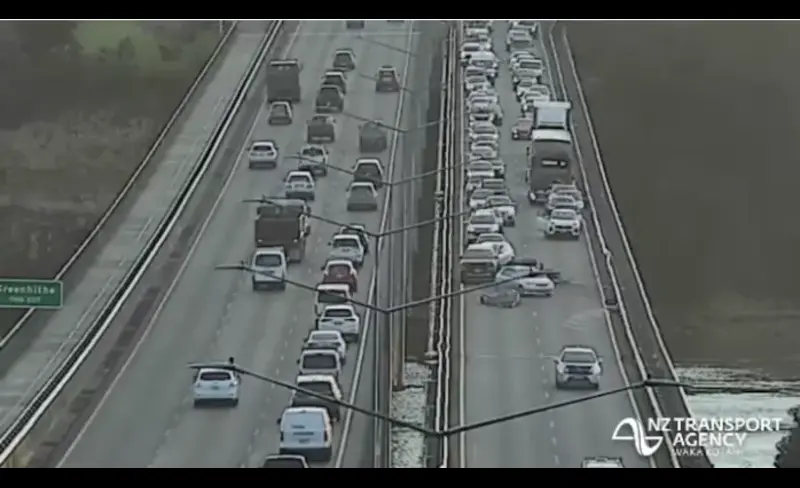When a Digger Fell Off a Truck in Auckland

A Reminder of Why Machinery Transport Safety Matters
On the morning of the 2nd of October 2025, Auckland commuters experienced an unexpected major traffic jam when a small excavator fell of a truck on the Upper Harbour Motorway (State Highway 18). The incident blocked a lane during peak hours, which caused a 5km queue and widespread delays. Thankfully, no injuries or damage to other vehicles were reported. However, for those of us in the construction and training industries, this is more than just a traffic incident and a news story, it's a reminder of why machinery transport safety is so important.
Why this Matters to the Construction and Machinery Industry
As someone who delivers WTR endorsement training (Wheels, Tracks & Rollers), I've seen first-hand how easy it can be to underestimate the risks of loading and transporting machinery. Operating a digger safely on site is one thing, but loading, securing, transporting and unloading it safely is another. It can be easy to overlook routine procedures of reoccurring tasks, but in transporting our machines from site to site, things can still go wrong.
A single loose tie-down, ramp fault or uneven load can cause serious consequences, not just financially but for people's lives. As we saw in Auckland, even when no one is hurt, the disruption and reputational impact can be significant.
"It's never the time you check the tie down that causes trouble, it's the one time you don't."
At ASWEFA (A Safe Working Environment For All), we try to make sure that machinery operators understand that safety doesn't stop when the engine turns off, it continues right through transport too.
Securing Your Load - Following the Truck Loading Code
When it comes to transporting machinery, load security isn't optional, it's a legal and moral responsibility.
The Truck Loading Code (officially the Code of Practice for the Safety of Loads on Heavy Vehicles) sets out how loads must be restrained to prevent movement during transport. It's the go-to guide for operators, drivers and businesses to ensure machinery stays secure, no matter the conditions.
Whether you're transporting a digger, roller, or loader, the rule is simple: every load must be restrained so it can't move, slide or fall, even under sudden braking, cornering or impact. The Code provides clear guidance on:
- Minimum restraint strength based on machinery weight and type
- Approved securing equipment like rated chains, binders, and straps
- Load distribution and balance for vehicle stability
- Inspection and maintenance of anchor points and tie-downs
These aren't just best practice tips, they're requirements designed to save lives. Load restraint failure can happen in seconds, but its consequences can last a lifetime.
WorkSafe's New Low Loader Ramp Guidance - What You Need to Know
In July 2025, WorkSafe NZ released updated guidance for the safe use and maintenance of low-loader ramps. This was following the tragic death of a worker in 2019, who was killed when a trailer ramp fell on him at work in Te Kuiti.
This new Good Practice Guide fills a critical gap for anyone who loads and unloads machinery. It outlines practical steps for safe ramp use, including:
- Controlling ramp-related high-energy hazards
- Avoiding standing beneath raised ramps and setting exclusion zones
- Conducting routine maintenance and inspections
- Using rated hydraulic systems and safety props when servicing
WorkSafe developed this guidance with CHASNZ, Civil Contractors NZ and Heavy Haulage NZ, a collaboration to make sure safety practices reflect the real conditions we face on the ground.
The Real-World Impact - It's Not Just About Rules
Rules and codes exist for a reason, but what really makes a difference is mindset. Incidents like the Auckland digger falling off the trailer remind us how small oversights, a missed chain or strap, a worn binder, a skipped inspection, can have big knock on effects.
These events also highlight how important training and awareness are. It's not just about having a license or endorsement. It's about understanding the why behind every step we teach.
At ASWEFA, we emphasise:
- Building a strong safety mindset
- Treating every task, whether it's operating, loading or transporting as if it's your first and most important
- Remembering that safety is a shared responsibility, from management to operators and everyone in between
Everyone plays a part in making sure every load, every trip and every day ends safely.
What You Can Do Right Now
If you're transporting machinery, even a short distance, here are simple steps that make a huge difference:
- Double-check your load restraints - tension, wear, rating, placement.
- Inspect ramps and trailers before use.
- Distribute weight evenly and secure attachments separately.
- Follow the Truck Loading Code - it's written to prevent exactly these incidents.
- Stay current with training - refresh your WTR or competency certifications regularly.
The Bigger Picture - Building Safer Habits Together
We were lucky that no one was hurt on the 2nd of October. But luck isn't a safety strategy.
Safety is built by habits, consistency and culture. It's checking the strap one more time, walking around the load once more and speaking up when something doesn't look right. At ASWEFA, our mission has always been simple, to create A Safe Working Environment For All. That means every operator, every truck driver and every company doing their part to make safety more than a checklist or tick box.
Because at the end of the day, the goal isn't just to get the job done, it's to get everyone home safe.







